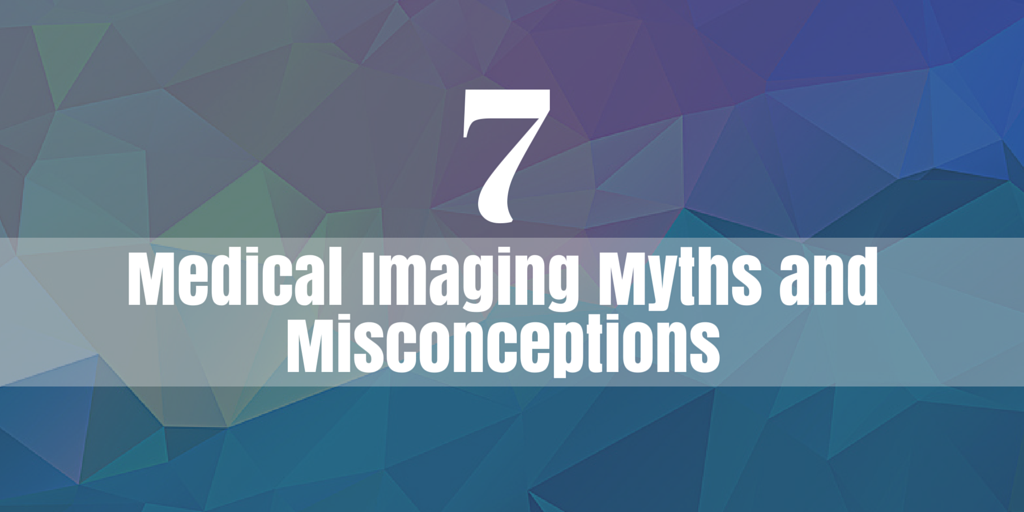There are many myths surrounding medical imaging that unfortunately frighten patients. These myths make them believe that medical imaging is dangerous. Many people believe that all imaging involves radiation which is certainly not true and one of the most hurtful myths. There are many type of medical imaging scans that do not involve radiation. Medical imaging is a way to determine if patients need surgery or treatment for an illness. It is also used to determine if treatment has been effective. Medical imaging has many useful applications that are extremely important in diagnosing patients.
Radiation is Dangerous to Everyone
Surprisingly, everyone is exposed to radiation during their everyday life from the earth. We are exposed to radon gas from space and in the soil. Even ,if you do not have a medical imaging test you are exposed to low levels of radiation every day. Food grown in radioactive soil had some radiation. There is no evidence that those that eat radioactive food are less healthy than others.
The radiologist that does the imaging has to obey several safety rules when conducting these tests. They choose lower doses of radiation and use imaging without radiation when needed. The radiation is targeted to the part of the body that needs to be viewed and often a lead apron is used for safety. We are exposed to radiation daily in small amount which is not harmful.
Radiation Imaging Produces Side Effects
Another myth is that radiation imaging will make your stomach queasy, cause headaches, and produce a number of negative symptoms. The truth is that radiation does not produce these symptoms. Most tests do not take that much time about ½ hour at the most. The radiologist is trained for using the machines safely and getting work done as quickly as possible. Again, the amount of radiation used is very low.
It is very rare to suffer any side effects from medical imaging. We get radiation every day from the soil, sun, and TV. This equipment diagnoses cancer so that it can be treated. This is one of the benefits of medical imaging.
X-Rays Are Harmful When Women Are Pregnant
During the first trimester X-rays can be dangerous to the developing of the fetus. If they are performed under the right conditions using safety measures pregnant women can get X-rays safely. Often during this time the doctor will use medical imaging equipment without radiation due to the risk. During pregnancy it is better to use medical imaging equipment that does not have radiation.
It would take large amount of radiation to cause birth defects and the fetus harm. In most cases tests are only given with radiation for serious medical reasons.
Radiation Affects Fertility
Another myth is that when you have medical imaging with radiation it will affect your fertility. Again you would have to be exposed to large doses of radiation for this to be true. There are no documented medical cases that any women has not been able to have children due to damage from medical imaging with radiation. This is another myth that has arisen from its frequent use for illness.
MRI’s Use Radiation
MRI’s do not use X-ray radiation like a CAT scan does. The imaging machines are similar in shape and size. It uses magnetic fields and radio frequency signals to produce an image. It is often used as an alternative to radiation when radiation is a concern for the patient’s health. MRI’s often take an hour and are more expensive than the CAT scan.
Ultrasounds Are Only Used For Pregnant Women
This is definitely not true. Ultrasounds are a common type of scan used on both men and women. They are used to see organs inside the abdominal area like the liver and kidneys. The scan is used to examine the heart and blood vessels, the muscles and joints, and pelvic organ. This test is used to help diagnose and treat many illnesses.
Traditional X-ray Are Outdated and No Longer Used
The truth is that traditional X-rays are still used in hospital and medical facilities. In fact, they account for 50% of all imaging tests performed. The provide excellent images of the bones and chest as compared to other medical imaging.
Some interesting facts about radiology are radiologists are doctors who specialize in diagnosing and treating disease and injuries using medical imaging equipment. The types of equipment they use are X-rays, MRI, CT, ultrasound, and PET position emission tomography. The common myths that surround medical imaging come from lack of knowledge and fear. Medical imaging is a very useful tool to diagnose and treat serious illnesses.
